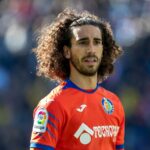The Uncertainty of Day 2, the Late Riser, and QB3
In a typical draft process, a quarterback will take the reigns early in the cycle. Typically once the previous draft has ended, sights will already be set on who the QB1 is in the next crop of signal callers. After watching the 2024 draft class produce six quarterbacks in the first round, it was expected that the class of 2025 would be a bit thinner.
It has certainly unfolded this way as we race towards April. The number one prospect for a lot of people last spring was Colorado’s Shedeur Sanders. Others had Carson Beck, but he stumbled through this past college football season, and now finds himself at Miami to replace the other top QB in this class, Cam Ward. Sanders and Ward have taken a stranglehold of the top positions in their crop. Ward has gotten a majority of the number one pick buzz, while many suggest Sanders is the true top guy, and that his famous father will probably prevent him from landing at the owners of the number one spot, the Tennessese Titans.
After those two, it becomes incredibly murky. Drew Allar was suggested to many as the potential QB3, but after a poor performance in the CFB semi-final, opted to return to Penn State for one more go. That leaves probably two potential options for the third quarterback selected. Alabama’s Jalen Milroe generated a lot of buzz throughout the year after a strong finish to 2023, but he needs some more seasoning. Jaxson Dart of Ole Miss has gotten much of the buzz the past two weeks, and some pundits have predicted he could rise all the way to the middle of round 1.
Along the fellow personalities here at ReRack, I am not sold on the potential of Jaxson Dart, and I liken his production in college to the Lane Kiffin scheme and talented receivers he had down in Oxford. He also didn’t produce in the biggest moments of 2024. I like his number of starts, his arm strength, and his mobility, but I have yet to be convinced. That being said, QB needy teams oftentimes will turn a blind eye to a prospects shortcomings, and pull the trigger on a player they believe have “franchise QB potential.” Nobody has ever defined what the potential really looks like.
For QB needy teams, there are important facts to consider if you are someone who wants Dart, Milroe, Kyle McCord, Will Howard, Dillon Gabriel, and whoever else could hear their name called on Day 2/3. They should also be worried about what being a late riser has done for some recent QB prospects.
In 2015, Florida State’s Jameis Winston and Oregon’s Marcus Mariota were the clear-cut one and two in the draft. Bryce Petty had a stellar college career at Baylor, and the same went for Brett Hundley out at UCLA. Instead, all of the pre-hype buzz went to little known Garrett Grayson out of Colorado State. An impressive pre-draft process allowed him to rise to the third round, where the New Orleans Saints tabbed him as a potential Drew Brees successor. Grayson was released after one season.
In the historically bad 2013 NFL Draft, the QBs reflected the lack of talent. Geno Smith was always the perceived number one guy, but he under-performed his final year at West Virginia. Smith’s down year and lack of second options allowed two men to rise. The first, Syracuse’s Ryan Nassib, was being regarded as a potential first round pick because many believed his play allowed his former coach, Doug Marrone, to land the head coaching job with Buffalo. Nassib ended up in round three, and enjoyed a very short career. The true riser was Florida State’s EJ Manuel, who Marrone ended up taking 16th overall. After losing his job to Tyrod Taylor in 2015, his career ended after a brief stint in Oakland.
Fast-forward to 2017. Mahomes, Watson, and Trubisky were first round locks. The man that Mahomes beat out at Texas Tech was David Webb, who had transferred to Cal and enjoyed a solid college career. His pre-draft performance saw him go in the third round of that draft. His smarts and intangibles that eventually led to him being the current QB coach for the Broncos did not lead to success.
My point is, pre-draft risers often fail. And I’m not referring to Joe Burrow or Jayden Daniels. Both elevated their stocks during their seasons. They proved it on the field. Same with Mahomes. But rather, the chatter of NFL media pundits and the hand measurement at the combine. That shouldn’t push a QB up.
If you’re looking for numbers, 26% of quarterbacks drafted in Day 2 of the draft since 2010 have had starter-worthy careers. Only two, Jalen Hurts and Russell Wilson, could you consider stars. Among the listed in the not-successful category are Cody Kessler, Jimmy Clauson, Christian Hackenberg, and many more players who did not live up to the hype. The success rate for first round QBs is 40%. Ideally, not great, but still better than 26%.
Furthermore, lets say Dart or Milroe fall to Day 2. The four quarterbacks who were the third QB selected and also Day 2 Picks: Malik Willis, Grayson, Mike Glennon, and Clauson. Not an inspiring list of names.
Even the round one QB3s haven’t been the most productive. Guys like Trey Lance, Paxton Lynch, and Blaine Gabbert are on that list. For arguments sake, Justin Herbert was selected as the third QB in 2020, but that was a rare draft where you could argue all four first round QBs hit (Burrow, Tua, Herbert, and Love). The fifth QB, Hurts, also hit. The 2020 class was special. Not all classes are special.
Picking an NFL caliber QB is arguably the hardest front office decision in professional sports. Only 32 men on the planet are asked to be guys that lead franchises. And if you were to look at the landscapes of QBs today, it’s not all sunshine. Many teams would rather have a different QB, so they’ll look at guys with the so-called high potential and put their jobs, and their teams fortunes on that potential.
So if you like Dart, you like Milroe, or any QB not named Ward or Sanders in this class, you should take them. But you’ve been warned.
One thought on “The Uncertainty of Day 2, the Late Riser, and QB3”
Comments are closed.







Milroe to the GMen. Josh Allen type player